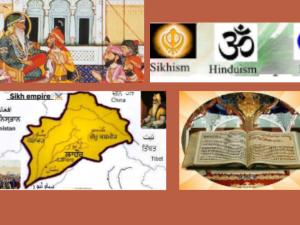The intersection of Artificial Intelligence (AI) and Sikhism (Sikhi) presents both opportunities and challenges. AI can enhance access to Sikh teachings, personalize spiritual education, and preserve cultural heritage through translation, automation, and archiving. However, weaknesses such as biased interpretations, over-reliance on technology, and loss of human connection pose significant challenges. Opportunities include expanding Sikhism’s global reach, automating gurdwara operations, and fostering interfaith dialogue through AI platforms. Yet, threats like the commercialization of spirituality, misinterpretation of teachings, and cultural homogenization must be considered. AI can support Sikh practices by promoting engagement and outreach, but it must be used cautiously to avoid undermining the spiritual depth and community focus central to Sikhism. A thoughtful, balanced approach is required to ensure AI serves as a tool for spiritual growth rather than a substitute for traditional methods of learning and practice in Sikhi.
Introduction
The rapid advancements in Artificial Intelligence (AI) are reshaping various aspects of human life, including religion and spirituality. Sikhism, a faith grounded in community service, equality, and self-reflection, is also witnessing the integration of AI into its practices. AI technologies offer new opportunities for global outreach, enhanced access to Sikh teachings, and the preservation of cultural heritage through tools like translation services and digital archiving. However, adopting AI also introduces challenges, including potential misinterpretation of spiritual teachings, loss of personal connection, and the risk of commercialization.
A SWOT (Strengths, Weaknesses, Opportunities, and Threats) analysis helps to explore how AI can complement Sikhism's spiritual framework while highlighting potential risks. By examining the benefits and limitations, we can better understand how to navigate the evolving relationship between technology and tradition in Sikhi, ensuring that AI enhances rather than detracts from spiritual practices.
Strengths
- Access to Knowledge: AI can be a powerful tool to disseminate Sikh teachings to a broader audience. With advanced natural language processing, AI can translate Sikh scriptures like the Guru Granth Sahib into multiple languages, helping people of various backgrounds engage with the teachings of the Gurus. Tools such as virtual assistants or AI-powered chatbots could answer questions about Sikhism, providing access to spiritual guidance anytime, anywhere.
- Community Engagement: AI-driven platforms can enhance community engagement by creating forums for discussion, sharing knowledge, and organizing events. Social media algorithms can foster digital congregations by connecting individuals interested in Sikh teachings, helping build an online sangat (community). AI tools for analyzing data can also provide insights into the needs of local Sikh communities, helping gurdwaras (Sikh temples) better serve their congregations.
- Preservation of Cultural Heritage: AI can help preserve Sikh history, art, and culture. For instance, deep learning algorithms could restore old manuscripts or generate high-resolution images of historical Sikh artifacts. AI could also archive and curate digital repositories of Sikh music, literature, and oral traditions, ensuring that future generations can access this valuable cultural heritage.
- Enhanced Education: AI-powered educational tools can personalize learning experiences for individuals wanting to understand Sikhi. With AI-driven platforms, people can study Sikh scriptures and philosophies at their own pace, with interactive features to assist comprehension. Tools like AI-based virtual tutors could simulate the role of spiritual mentors, helping students understand complex concepts from Sikh texts.
Weaknesses
- Interpretation and Bias: One of the main challenges in integrating AI into Sikhi is the risk of biased interpretations of the teachings. AI algorithms depend on the data they are trained on, and if the dataset used for training is skewed or incomplete, it may misrepresent Sikh principles. AI cannot grasp the nuanced meanings embedded in spiritual texts, often requiring human interpretation from learned scholars (Gianis).
- Over-reliance on Technology: Over-dependence on AI for religious and spiritual guidance might reduce personal effort and reflection, which are core to the Sikh practice of self-growth and discipline. For example, replacing the personal reading and reflection on Gurbani (the word of the Guru) with an AI interpretation might weaken individual spirituality.
- Loss of Human Touch: Sikhism significantly emphasizes community, collective prayer, and personal guidance from spiritual mentors. While AI can provide digital solutions, it cannot replace the human connection felt in communal spaces like gurdwaras or during personal discussions with a spiritual leader.
- Data Privacy Concerns: AI-based platforms require personal data to function effectively, and Sikhs may be concerned about privacy when interacting with AI applications. The commercialization of spiritual apps could lead to exploitation or misuse of personal data, leading to distrust in AI-driven solutions.
Opportunities
- Global Outreach: AI offers an opportunity to spread Sikh teachings globally, particularly among younger generations more attuned to digital platforms. This can also help bridge the gap between Sikh diasporas and their heritage by offering immersive experiences, such as virtual gurdwaras or AI-generated holographic sermons from respected leaders.
- Automation in Gurdwaras: AI could streamline administrative tasks in gurdwaras, such as managing schedules, donations, and langar (free community kitchen) services. Automation could enhance the operational efficiency of gurdwaras, allowing them to focus more on spiritual activities and community outreach.
- Spiritual Growth via AI Tools: AI-driven tools for meditation, like guided sessions based on Sikh teachings, can aid in spiritual growth. Augmented reality (AR) experiences or virtual reality (VR) could also be used to provide immersive, meditative experiences inspired by Sikh traditions, such as being surrounded by kirtan (devotional music).
- Interfaith Collaboration: AI technologies can facilitate interfaith dialogue by creating spaces where Sikhs can engage with people of other faiths through discussions, AI-moderated forums, and knowledge-sharing platforms. This can foster understanding and mutual respect, which aligns with the Sikh ethos of recognizing the divine in all beings.
Threats
- Commercialization of Spirituality: There is a risk that the commercialization of AI applications designed to cater to Sikhi could dilute the spiritual integrity of the teachings. Suppose profit-driven companies design AI tools for Sikh practice. In that case, it may lead to monetization of services that should be freely available to all, such as access to religious texts and sermons.
- Misinterpretation of Teachings: AI can process large amounts of information quickly but may lack the sensitivity to interpret Sikh teachings correctly. Misinterpretations or partial representations could mislead users who rely solely on AI for their spiritual growth, possibly distorting the core values of Sikhism.
- Dehumanization of Religion: There is a potential threat that using AI in religious practices may lead to the dehumanization of spirituality. Sikhism emphasizes personal effort in understanding and living according to spiritual values. If AI becomes a primary source of religious guidance, it may reduce the personal connection that is fundamental to the Sikh way of life.
- Cultural Homogenization: AI algorithms often promote uniformity to cater to broad audiences. This could lead to a loss of Sikhi's unique cultural aspects, mainly if AI-generated content dilutes regional or traditional nuances in favour of a globalized version of Sikh practice.
Conclusion
The integration of AI into Sikhi presents both significant opportunities and challenges. While AI offers the potential to globalize the teachings of Sikhism, enhance community engagement, and preserve cultural heritage, it also risks misinterpreting spiritual content and dehumanizing religious practices. A balanced approach that respects Sikhi's core values while leveraging AI's strengths could ensure that technology is a complementary tool for spiritual growth rather than replacing traditional ways of learning and practicing the faith.
Further Reading:
- Dessislav Dobrev, Artificial Intelligence and the Law: A Comprehensive Guide for the Legal Profession, Academia and Society. Carswell. Sept. 2021. ISBN: 9780779898930
- Jason Thacker. The Age of AI: Artificial Intelligence and the Future of Humanity. Zondervan. March 2020.
- Prof Luciano Floridi.The Ethics of Artificial Intelligence: Principles, Challenges, and Opportunities. Oxford University Press. Sept. 2023.
- Markus Dubber, Frank Pasquale, & Sunit Das. Oxford Handbook of Ethics of AI. Oxford University Press. May 2021. ISBN-13 978-0197601440
- John C. Lennox. 2084: Artificial Intelligence and the Future of Humanity. Zondervan. June 2020
- Devinder Pal Singh, Impact of Artificial Intelligence on Science-Religion Dialogue. Horizon J. Hum. Soc. Sci. Res. 6 (1), 27–33. 2024. https://doi.org/10.37534/ bp.jhssr.2024.v6.n1.id1232.p27
- Devinder Pal Singh, AI and Sikhism: Ethical Stewardship and Moral Challenges in the Digital Age. SikhNet.com. 31 May 2024. https://www.sikhnet.com/news/ai-and-sikhism%C2%A0
- Devinder Pal Singh, Challenges of AI for Promoting Sikhism in the 21st Century (Guest Editorial). The Sikh Review, Kolkata, India. 71(9). 6-8. Sept. 2023. (DOC) Challenges of AI for Promoting Sikhism in the 21st Century (Guest Editorial) | Devinder Pal Singh - Academia.edu
- Devinder Pal Singh, Sikhism and Artificial Intelligence - The Mutual Relevance. Understanding Sikhism - The Research Journal, Montreal, QC, Canada, 25(1). 153-157. Jan.-Dec. 2023.
- Devinder Pal Singh, Artificial Intelligence and Its Impact on Punjabi Culture. Punjab Dey Rang. Lahore. Pakistan. 17(3). 5 -10. July-Sept. 2023.
*******






